Knifofia (kniphofia): description, varieties and types, planting and care

Knifofia is a herbaceous plant, the homeland of which is considered to be Africa. An exotic evergreen representative of the flora is characterized by interesting external features. Culture buds change their color throughout the season, and this characteristic attracts the attention of many gardeners.




Description
Tritoma, or knifofia, is a worthy representative of the flora for open ground. The plant has narrow, long foliage up to 0.9 meters high. Designers often use it to make bouquets in conjunction with other flowers. The tritoma inflorescence has an external resemblance to the lupine green manure. Its length ranges from 10 to 25 centimeters.
A peculiarity of the culture can be called its original flowers. They look like elongated torches and consist of several inflorescences. The color of the buds can be red, orange, yellow. This beautifully flowering representative of the flora is characterized by a love of shade, it thrives best in the southern region. The total plant height can range from 100 to 300 centimeters.
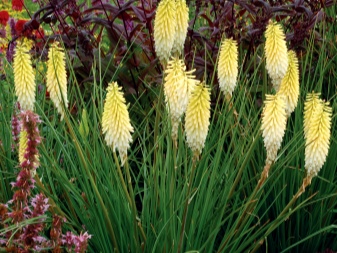



The rhizome of the bush is thick and short. The appearance of the fruit looks like a box. Flowers are usually concentrated at the top of the stem. The beginning of flowering is considered to be July; at the end of this phase, the cniphophy does not lose its decorative effect. A feature of this culture can be called the fact that its flowers do not bloom at the same time. This process is characterized by the gradual appearance of buds.
Knifofia during flowering is a picturesque sight. The effect of originality and decorativeness is hidden in large colorful flowers, as well as dense foliage that is collected in a bunch. African beauty is often grown not only in home gardens, but also in containers.




Types and varieties
We list the most popular varieties and varieties of perennial shrubs with a decorative appearance.
Tukka is a cold-resistant representative of flora with a height of no more than 0.8 meters
This non-capricious plant is resistant to temperature extremes. The tritoma of this species is characterized by large inflorescences with a size of about 15 centimeters. The perennial feels great both in apartment conditions and in an open area. Two varieties of this type are most in demand.
- "Alcazar". The plant can grow up to 1 meter in height. It blooms from July to August. The flowers of the culture are colored orange.
- Fleming Torch is a low bushes growing up to 60 centimeters. During flowering, the culture is decorated with yellow-red flowers.

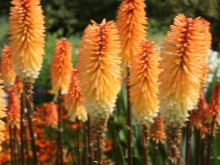

Hybrid
The plant is characterized by the original color of the inflorescences. The basis for hybridization is berry kniphofia. Peduncles can have different heights depending on the variety. Popular varieties of hybrid knifophy: Atlanta, Cobra, Cardinal.



Berry
The plant of this species belongs to tall - some of its varieties can grow up to 200 centimeters. The inflorescence of the culture is large with a diameter of 25 centimeters. This tritome is characterized by a bright palette of colors. Plantings from berry knifofia can be an excellent decor for an open area, lawn or garden. Several varieties of the plant are popular.
- Eskimo. The culture is presented in the form of meter bushes. During flowering, yellow flowers of the plant are located in its lower part. The upper buds are orange or bright coral in color.
- "Dr. Kerr" has peduncles 1 meter long. The inflorescences do not exceed 0.2 meters in height. Lemon flowers give the bush decorativeness.


Often in the garden plots you can find such varieties of bnifofia as "African Guest", which is characterized by a mixture of colors in the buds, as well as "Surprise", "Grandiflora", "Uvaria".




Landing rules
Growing knifofia in a flower bed, as well as in indoor conditions, requires not only proper care, but also competent planting. In order for the African perennial to take root in a different climate, it will need comfortable conditions. First of all, it is worth choosing the most suitable site and soil. Tritoma is a thermophilic plant, so bright lighting won't hurt it. In the absence of good light, the culture can get sick or die.
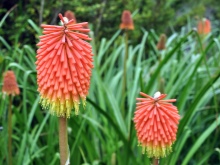


Territories in the area of a semi-submerged lowland pose a danger to the knifophia. A bush planted in a similar area will suffer from a lack of oxygen and rotting of the root system. The best option for planting a decorative representative of the flora is an open area and a slide. This area contributes to the rapid heating of the root system and stimulates its growth.
A rooted bush does not need shelter from the sun, but it is better to shade a young seedling.


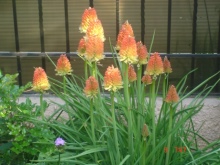
A bright perennial grows well and develops in drained soil with an admixture of sand. And also gardeners should not forget about maintaining constant soil moisture. Loams are considered suitable for knifophy, but this type of soil has to be additionally fertilized. When choosing a clayey site for planting tritomas, the ground should be dug up first, mixed with turf soil, sand or peat. To improve the nutritional characteristics of the substrate, it is worth adding humus to it.

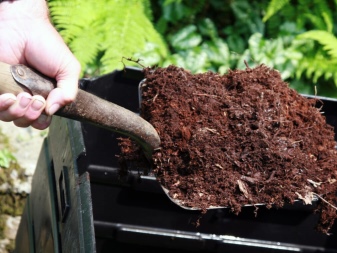
Follow-up care
It will not be difficult even for an inexperienced gardener to grow knifophy in the Moscow region or in another region of Russia. The first phase of flowering of the shrub falls on the next season after planting, provided that the root system is strengthened. In order for the plant to please with its decorative effect, it is worthwhile to moderately moisten the soil, weed, mulch, loosen it, and also fertilize the culture.


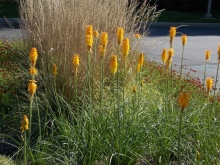
Watering
Irrigation of tritomas can be carried out by spraying or watering at the root. It is strictly forbidden to perform this procedure in the heat of the day, otherwise the plant will burn the foliage and lose its decorative effect. In summer, it is necessary to irrigate the shrub every 3-4 days. In winter, when in the basement, the knifofia is watered every 30 days. The main rule in this event is to maintain low soil moisture.
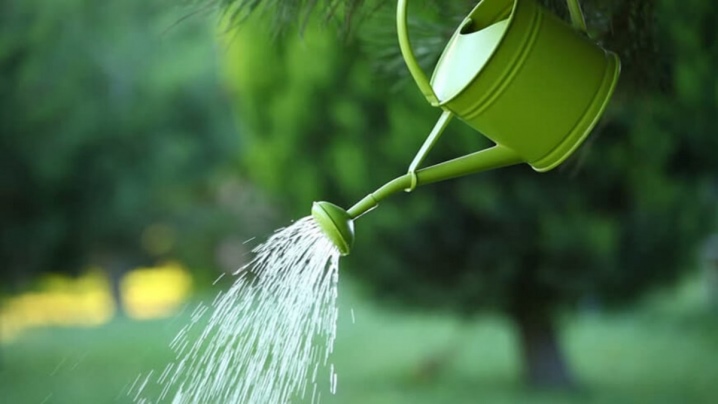
Fertilizer
At the beginning of the growing season, the plant needs nitrogen-containing fertilizing. For this purpose, you can use a complex mixture, for example, azophoska, nitroammophoska, urea, saltpeter, double or ordinary superphosphate. It is not worth using nitrogen for a long time, since the active development of green mass with delayed flowering or its absence is possible.
Before the flowering phase, you can fertilize trito with potassium substances. Potassium is able to support the decorativeness of the plant, namely: the splendor of its inflorescences, the brightness of the buds. In addition, cniphophy that is fertilized with potassium persists for a long time in a cut state.




The culture needs phosphorus during the growing season. Fertilizer is applied to autumn flower beds, as well as in the spring before the planting process. For this purpose, it is possible to use phosphate rock, which is considered a long-acting fertilizer. This top dressing must be applied to the ground every 3-4 years.
Of organic fertilizers, humus is considered the most suitable for knifophy. Fresh manure can be hazardous due to the release of methane that burns the root system. Many gardeners infuse wood ash or mix the substrate with compost.


Pruning
It is necessary to cut off the yellowed foliage of an ornamental shrub in the spring, after removing the film cover. If the knifofia spent the winter in the basement, then she does not need this procedure. At the end of the flowering phase, it is required to eliminate the peduncles up to the root. Otherwise, old flower stalks will take nutrients from the roots.


Preparing for winter
A tritoma growing in middle latitude is not long-lived. But within a few years, she will be able to decorate the site with her presence. Before the onset of winter, the bush should be cut off the arrows without affecting the leaves. Preparing the flower for the cold, tritoma foliage should be carefully tied. The next steps will be to cover the shrub with peat chips and cover with spruce branches.
On top of the embankment, the knifofia should be covered with a waterproof material, for example, a film or roofing material. In the spring, the shelter must be removed. After that, the bushes are carefully examined, those shoots that have turned yellow or damaged by frost are cut off.


Transplant in the fall
Digging up a culture and bringing it into the room can extend its life. To do this, it is worth removing the flower from the soil, then planting it in a large container. The room in which the knifofia will be stored must be cool. The gardener should make sure that the root system of the shrub does not dry out, so from time to time the culture should be watered with a small amount of liquid. Planting tritomas in open soil can be done in late spring or early summer.

Reproduction
Knifofia reproduces not only from seeds at home, but also vegetatively. The first option is laborious, so it is rarely used. Gardeners use vegetative propagation more often.
Seed method
If you want to propagate trito with seeds on your own, you should use only purchased seed material. In mid-March, you can start sowing seeds in a container that contains the potting soil. To increase the germination capacity, the container with crops should be covered with foil and left for several weeks. A homemade greenhouse needs ventilation and soil moisture.
Seedlings that have just appeared should be hardened using room temperature. When the first pair of leaves is formed, the culture can begin to dive into separate containers. In July, the herb can be planted in a permanent place. A flower that has been propagated in this way is capable of blooming in the third year of life.

By dividing the bush
Bush division is considered a simpler option for shrub propagation. In an adult 3-year-old plant, daughter-type rosettes are formed, which are later used for reproduction. In May, the gardener should cut off the daughter rosettes from the mother shrub with a sharp knife. The cut must be dried and sprinkled with charcoal.
After several hours have passed since the cutting of the planting material, you can start planting it in the holes that have been prepared in advance. The pits are filled with a nutrient substrate. The first few weeks after planting, the plant must be well watered, eventually reducing the frequency of irrigation to 1-2 times every 7 days. Tritoma, which is propagated by bush division, will be able to please with flowering as early as the next season.

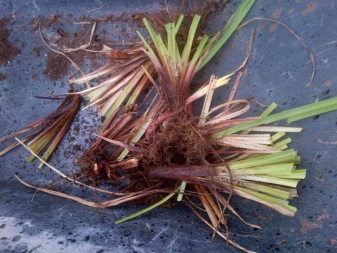
Diseases and pests
According to gardeners' reviews, knifofia is quite rare. If the culture is attacked by leaf-eating or sucking insects, for example, aphids, thrips, spider mites, it should be treated with insecticides. In the case of frequent watering or stagnation of moisture, the crop may suffer from root rot. To eliminate this ailment, you can use fungicides. If this method does not help, then the perennial should be eliminated from the site in order to avoid contamination of other representatives of the flora.


Application in landscape design
When creating a flower arrangement on a site, it is worth taking into account the flowering time, watering frequency, vegetation height and flowering duration. The following representatives of the flora can become worthy neighbors for an African beauty:
- iris;
- sage;
- gypsophila;
- lupine;
- maned barley;
- ripsalis;
- santolina;
- sticky tar;
- dahlia;
- decorative cereal.
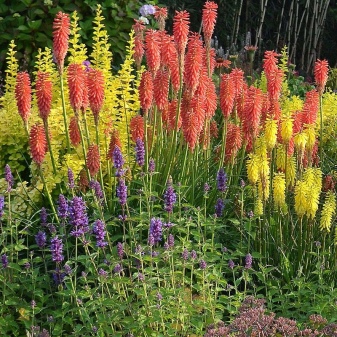

The peculiarity of the African plant is that it does not lose its decorative qualities throughout the growing season. Due to this characteristic, the culture is often used by landscape designers. Knifofia can be planted as a central plant in a flower bed or when combined with other representatives of the flora.

Tall varieties of plants can be used to create a visual screen, and with the help of undersized varieties, they can be used to decorate an alpine slide or rockery. Group plantings of knifofia on the lawn will look spectacular when decorating a reservoir or a mixed flower garden. By decorating the border with this representative of the flora, you can create a wall of bright orange lights in the form of flowers.

Every gardener who loves to grow flowering vegetation will eventually want to plant an exotic crop from distant lands. Knifofia is considered such a bright and interesting decorative representative of the flora. This bush is characterized by ease of planting and undemanding care. A gardener does not have to spend a lot of time and effort on caring for a plant, however, when performing simple activities for growing a crop, you can transform your garden with decorative bright flowers.

For an overview of the book, see the video below.







































































































The comment was sent successfully.